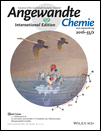Dual-Targeting Nanovesicles for In Situ Intracellular Imaging of and Discrimination between Wild-type and Mutant p53
Graphical Abstract
Abstract
p53 is a tumor-suppressor protein related to the cell cycle and programmed cell apoptosis. Herein, dual-targeting nanovesicles are designed for in situ imaging of intracellular wild-type p53 (WTp53) and mutant p53 (MUp53). Nanovesicle-encapsulated plasmonic gold nanoparticles (AuNPs) were functionalized with consensus DNA duplexes, and a fluorescein isothiocyanate (FITC)-marked anti-MUp53 antibody was conjugated to the nanovesicle surface. After entering the cytoplasm, the released AuNPs aggregated through recognition of WTp53 and the double-stranded DNA. The color changes of AuNPs were observed using dark-field microscopy, which showed the intracellular WTp53 distribution. The MUp53 location was detected though the immunological recognition between FITC-labeled anti-MUp53 and MUp53. Thus, a one-step incubation method for the in situ imaging of intracellular WTp53 and MUp53 was obtained; this was used to monitor the p53 level under a drug treatment.





